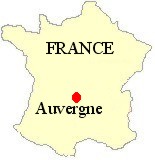
|
|
|||||
Altitude, geology and soil content have determined the agriculture of the Auvergne. On the high plateaux of the Dôme, Gevaudan and Cantal, you find cattle and sheep. Vines are grown on the limestone hills and valley slopes and grain is planted on the rich black soil of the Limagnes plain. This region is home to a fervent Catholic community and the festivals are predominantly religious. Since 1095AD when Pope Urban began preaching, many crusades and pilgrimages have originated in the Auvergne. The Monts du Forez are on the eastern side of the Auvergne and the cattle graze at altitudes of 500 to 1500 metres. The summers are hot and the winters long and cold. The local town of Ambert has become renowned for its distinctive blue cheese. Originally it was made in the 'jasseries' or 'astives', the summer farmhouses on the plateaux. Today manufacturing has moved to the small co-operatives of the Monts du Livradois and the Forez plain but the same skills are used which have been passed down from generation to generation. The cheese is made with unpasteurised cows milk, 25 litres of milk for each cheese. Penicillium glaucum bacteria, a distant cousin of Penicillium roquefortii, is used to seed the curd just after curdling. It is neither pressed nor cooked before moulding, to preserve a fine, aerated texture. The word 'Fourme' is taken from the Latin 'forma', meaning form or shape (it is believed that the word 'fromage' has the same roots). The blue mould only appears after air has been introduced into the cheese using hollow needles. Maturation takes a minimum of one month but can take place for up to five months. During this time the cheeses are regularly brushed. Fourme d'Ambert is one of the mildest of the blue cheeses. It's paste is creamy and firm and it has the smell of a damp cellar. It has a natural grey dry rind with reddish spots. Fourme d'Ambert was awarded its AOC status on 9th May '72 along with another cheese called Fourme d'Montbrison It was modified again on 29th December '86. Fourme d'Montbrison is almost identical to Fourme d'Ambert and is made, as one would expect, around the town of Montbrison, also in the Auvergne. The cheese is available all year round and is best enjoyed with a medium-bodied red wine such as the local Côtes-du-Forez. At large gatherings little chimneys are dug into the cheese which are filled with eau-de-vie and enjoyed as some British enjoy their Stilton with port. Each cheese is shaped like a tall cylinder with a height of approximately 20cm and a diameter of 13cm. Each weighs 1.8kg and has a fat content of 50%. Click here or press your 'Back' button to return |
|
|||||
| All articles © www.teddingtoncheese.co.uk | ||||||
